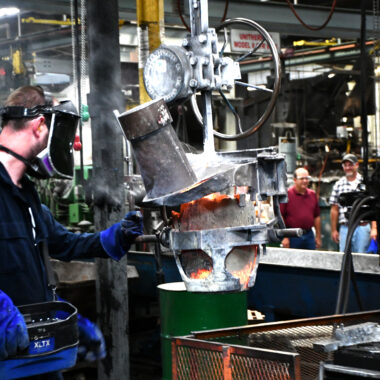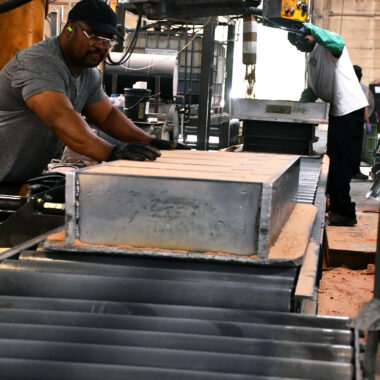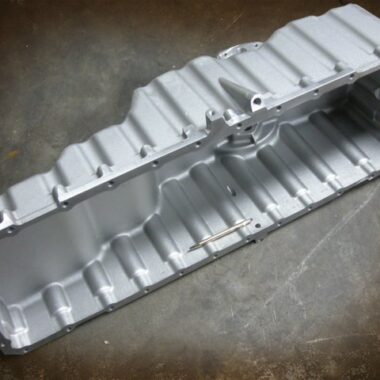Unraveling About Aluminum Casting: From Basics to Expertise
Unraveling About Aluminum Casting: From Basics to Expertise
Blog Article
Crafting Excellence: How to Accomplish High-Quality Light Weight Aluminum Castings Every Single Time
In the world of light weight aluminum spreading, the quest of excellence is a constant trip that needs a careful approach and an eager understanding of the complexities included. Accomplishing regular high-quality light weight aluminum spreadings demands a thorough grasp of the procedures, from selecting the proper alloy to executing exact mold and mildew designs and diligently controlling casting criteria. However, truth proficiency lies in the capability to implement these aspects flawlessly to create flawless castings whenever. As we check out the ins and outs of crafting excellence in aluminum spreadings, revealing the vital strategies and methods that cause impressive outcomes becomes critical for those pursuing excellence in this specialized area.
Recognizing Light Weight Aluminum Casting Processes
Aluminum casting procedures, crucial in the production market, involve the detailed improvement of molten aluminum right into solid kinds with a series of meticulously regulated steps. Recognizing these procedures is paramount to attaining top notch aluminum spreadings regularly - about aluminum casting. The main techniques made use of in aluminum spreading are die spreading, sand casting, and financial investment spreading

Each of these procedures has its advantages and is picked based on variables like complexity, quantity, and desired coating of the aluminum casting. about aluminum casting. Understanding the details of these techniques is crucial for makers aiming to create high-quality light weight aluminum spreadings regularly
Selecting the Right Aluminum Alloy
Picking the proper aluminum alloy is a vital decision in the manufacturing of high-grade light weight aluminum castings. When selecting an aluminum alloy for spreading, it is necessary to consider the details needs of the application to guarantee optimal efficiency.
One of the most generally used light weight aluminum alloys for spreading is A356 - about aluminum casting. For applications needing high toughness, 7075 light weight aluminum alloy is a prominent selection due to its remarkable strength-to-weight proportion.
Along with mechanical buildings, considerations such as expense, accessibility, and post-casting processes must additionally influence the option of the best light weight aluminum alloy. By thoroughly evaluating these variables, producers can make sure the manufacturing of high-grade aluminum spreadings that meet the desired specs.
Carrying Out Correct Mold Layout
Developing an effective mold and mildew layout is critical for ensuring the effective manufacturing of top notch aluminum spreadings. Correct mold design plays a considerable role in achieving the desired characteristics of the end product. To execute a successful mold layout, variables such as product flow, cooling prices, and component geometry have to be meticulously taken into consideration.
One secret aspect of mold layout is ensuring correct filling and solidification of the aluminum within the mold and mildew cavity. This involves making jogger and gating systems that help with smooth metal circulation and avoid defects such as air entrapment or insufficient filling. In addition, integrating cooling networks into the mold and mildew layout helps control solidification prices and decrease the threat of porosity or shrinking defects.

Controlling Casting Parameters

Guaranteeing Post-Casting Top Quality Checks
To maintain the high top quality of light weight aluminum spreadings, complete post-casting high quality checks are necessary. After the spreading process is completed, it is crucial to guarantee that the final items satisfy the preferred standards and requirements.
Dimensional precision is one more vital element that should be verified during post-casting quality checks. Dimensions of key measurements and resistances ought to be taken to validate that the castings satisfy the required requirements. In addition, mechanical residential or commercial properties such as hardness, tensile toughness, and influence resistance may need to be reviewed with material screening to guarantee that see the castings have the needed stamina and durability for their designated application.
Conclusion
Finally, accomplishing high-quality light weight aluminum spreadings requires a comprehensive understanding of the spreading processes, choosing the suitable alloy, developing mold and mildews efficiently, regulating casting criteria meticulously, and carrying out post-casting top quality checks vigilantly. By adhering to these actions, producers can consistently generate light weight aluminum castings that satisfy the highest possible standards of high quality and efficiency.
Attaining consistent top notch light weight aluminum castings demands a thorough grasp of the processes, from choosing the ideal alloy to performing exact mold and mildew designs and carefully regulating spreading parameters. The primary techniques utilized in light weight aluminum casting are pass away spreading, sand casting, and investment spreading.
Financial investment casting, likewise understood as accuracy casting, entails producing wax patterns that are covered in additional resources ceramic to form mold and mildews.Selecting the ideal aluminum alloy is an important choice in the manufacturing of premium light weight aluminum spreadings.Ensuring specific control over spreading specifications is necessary for preserving consistency and quality in aluminum spreading manufacturing.
Report this page